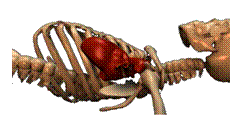Why Chest Compressions Have to be Correct
The way that you provide emergency assistance to a victim makes a difference in their chances of survival. The science is in:
"the better your perform chest compressions, the better the victim's chance of survival."
- Rate. A rate of less than 100 per minute will decrease forward blood flow, and a rate greater than 100 will increase fatigue, which leads to other performance errors.
- Depth. Less than 1.5 inches will reduce blood flow and greater than 2 inches will increase the likelihood of permanently injuring the victim.
 3. Full chest recoil. When a compression is released, elastic recoil of the chest will create a negative pressure that pulls blood back into the chest. Incomplete decompression will reduce the amount of blood available to be circulated with the next compression.
3. Full chest recoil. When a compression is released, elastic recoil of the chest will create a negative pressure that pulls blood back into the chest. Incomplete decompression will reduce the amount of blood available to be circulated with the next compression.
4. There is evidence to suggest that it takes 3 to 7 compressions to restore aortic pressure and cerebral perfusion pressure after a pause. In simple terms this means that it takes 3 to 7 compressions to get the blood flowing. Thus the repercussion of performing several poor compressions in a row is much greater than used to be thought. It is now believed to have direct consequences for survival of a victim.

